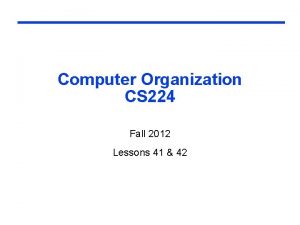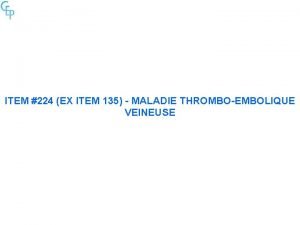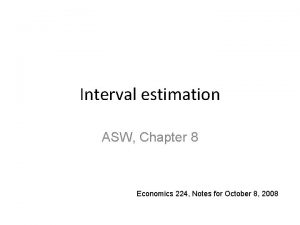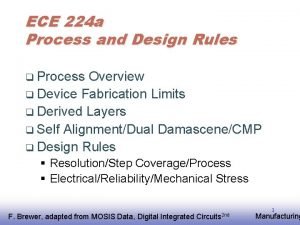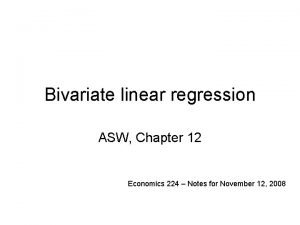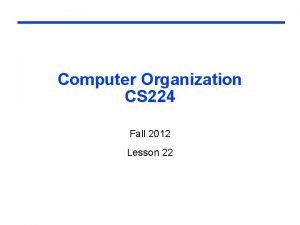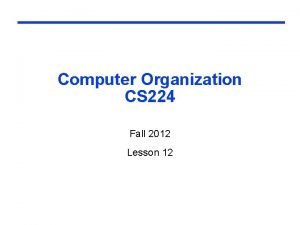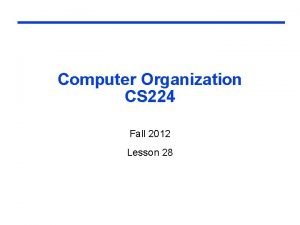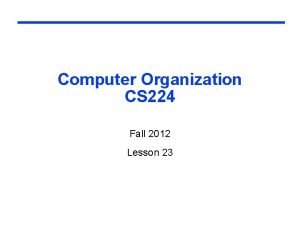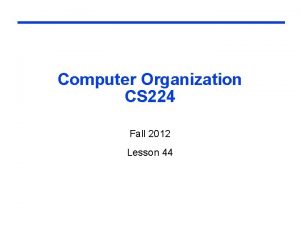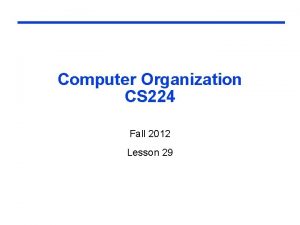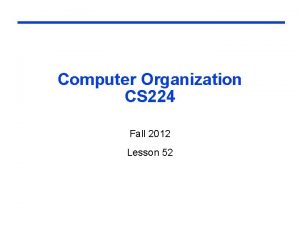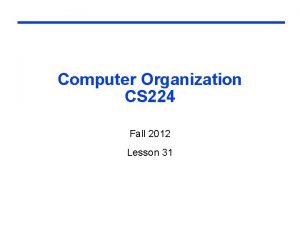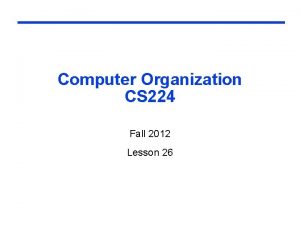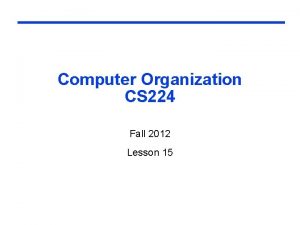Computer Organization CS 224 Fall 2012 Lesson 21












- Slides: 12

Computer Organization CS 224 Fall 2012 Lesson 21

FP Example: °F to °C q C code: float f 2 c (float fahr) { return ((5. 0/9. 0)*(fahr - 32. 0)); } fahr in $f 12, result in $f 0, literals in global memory space q Compiled MIPS code: f 2 c: lwc 1 div. s lwc 1 sub. s mul. s jr $f 16, $f 18, $f 0, $ra const 5($gp) const 9($gp) $f 16, $f 18 const 32($gp) $f 12, $f 18 $f 16, $f 18

FP Example: Array Multiplication q. X l q. C =X+Y×Z All 32 × 32 matrices, 64 -bit double-precision elements code: void mm (double x[][], double y[][], double z[][]) { int i, j, k; for (i = 0; i! = 32; i = i + 1) for (j = 0; j! = 32; j = j + 1) for (k = 0; k! = 32; k = k + 1) x[i][j] = x[i][j] + y[i][k] * z[k][j]; } l Addresses of x, y, z in $a 0, $a 1, $a 2, and i, j, k in $s 0, $s 1, $s 2

FP Example: Array Multiplication n MIPS code: li li L 1: li L 2: li sll addu l. d L 3: sll addu l. d … $t 1, 32 $s 0, 0 $s 1, 0 $s 2, 0 $t 2, $s 0, 5 $t 2, $s 1 $t 2, 3 $t 2, $a 0, $t 2 $f 4, 0($t 2) $t 0, $s 2, 5 $t 0, $s 1 $t 0, 3 $t 0, $a 2, $t 0 $f 16, 0($t 0) # # # # $t 1 = 32 (row size/loop end) i = 0; initialize 1 st for loop j = 0; restart 2 nd for loop k = 0; restart 3 rd for loop $t 2 = i * 32 (size of row of x) $t 2 = i * size(row) + j $t 2 = byte offset of [i][j] $t 2 = byte address of x[i][j] $f 4 = 8 bytes of x[i][j] $t 0 = k * 32 (size of row of z) $t 0 = k * size(row) + j $t 0 = byte offset of [k][j] $t 0 = byte address of z[k][j] $f 16 = 8 bytes of z[k][j]

FP Example: Array Multiplication … sll $t 0, $s 0, 5 addu $t 0, $s 2 sll $t 0, 3 addu $t 0, $a 1, $t 0 l. d $f 18, 0($t 0) mul. d $f 16, $f 18, $f 16 add. d $f 4, $f 16 addiu $s 2, 1 bne $s 2, $t 1, L 3 s. d $f 4, 0($t 2) addiu $s 1, 1 bne $s 1, $t 1, L 2 addiu $s 0, 1 bne $s 0, $t 1, L 1 # # # # $t 0 = i*32 (size of row of y) $t 0 = i*size(row) + k $t 0 = byte offset of [i][k] $t 0 = byte address of y[i][k] $f 18 = 8 bytes of y[i][k] $f 16 = y[i][k] * z[k][j] f 4=x[i][j] + y[i][k]*z[k][j] $k k + 1 if (k != 32) go to L 3 x[i][j] = $f 4 $j = j + 1 if (j != 32) go to L 2 $i = i + 1 if (i != 32) go to L 1

Accurate Arithmetic q IEEE Std 754 specifies additional rounding control l Extra bits of precision (guard, round, sticky) l Choice of rounding modes l Allows programmer to fine-tune numerical behavior of a computation q Not l all FP units implement all options Most programming languages and FP libraries just use defaults q Trade-off between hardware complexity, performance, and market requirements

Support for Accurate Arithmetic q IEEE 754 FP rounding modes • • q Always round up (toward +∞) Always round down (toward -∞) Truncate (toward 0) Round to nearest even (when the Guard || Round || Sticky are 100) – always creates a 0 in the least significant (kept) bit of F Rounding (except for truncation) requires the hardware to include extra F bits during calculations • • • Guard bit – used to provide one F bit when shifting left to normalize a result (e. g. , when normalizing F after division or subtraction) G Round bit – used to improve rounding accuracy R Sticky bit – used to support Round to nearest even; is set to a 1 whenever a 1 bit shifts (right) through it (e. g. , when aligning F during addition/subtraction) S F = 1. xxxxxxxxxxxx G R S

q Parallel programs may interleave operations in unexpected orders § 3. 6 Parallelism and Computer Arithmetic: Associativity • Assumptions of associativity may fail, since FP operations are not associative ! • Need to validate parallel programs under varying degrees of parallelism

q Originally based on 8087 FP coprocessor l 8 × 80 -bit extended-precision registers l Used as a push-down stack Registers indexed from TOS: ST(0), ST(1), … l q FP l l values are 32 -bit or 64 -bit in memory Converted on load/store of memory operand Integer operands can also be converted on load/store q Very l difficult to generate and optimize code Result: poor FP performance § 3. 7 Real Stuff: Floating Point in the x 86 FP Architecture

x 86 FP Instructions Data transfer Arithmetic Compare Transcendental FILD mem/ST(i) FISTP mem/ST(i) FLDPI FLD 1 FLDZ FIADDP FISUBRP FIMULP FIDIVRP FSQRT FABS FRNDINT FICOMP FIUCOMP FSTSW AX/mem FPATAN F 2 XMI FCOS FPTAN FPREM FPSIN FYL 2 X q Optional l l mem/ST(i) variations I: integer operand P: pop operand from stack R: reverse operand order But not all combinations allowed

Streaming SIMD Extension 2 (SSE 2) q Adds 4 × 128 -bit registers l q Extended to 8 registers in AMD 64/EM 64 T Can be used for multiple FP operands l 2 × 64 -bit double precision l 4 × 32 -bit single precision l Instructions operate on them simultaneously - Single-Instruction Multiple-Data

q ISAs support arithmetic l l q Bounded range and precision l q Signed and unsigned integers Floating-point approximation to reals Operations can overflow and underflow MIPS ISA l l Core instructions: 31 integer + 23 arithmetic 54 most frequently used –Figure 3. 24 - 100% of SPECINT (p. 282) - 97% of SPECFP ( “ “) l q Other instructions: much less frequent: Figure 3. 25 See Fig 2. 45 and Fig 3. 26 § 3. 9 Concluding Remarks
 Cs-224 computer organization
Cs-224 computer organization Process organization in computer organization
Process organization in computer organization Basic structure of computer system
Basic structure of computer system Difference between computer organization and architecture
Difference between computer organization and architecture Design of basic computer with flowchart
Design of basic computer with flowchart Design of basic computer with flowchart
Design of basic computer with flowchart Concrete crack comparator card
Concrete crack comparator card Kohlberg's stages
Kohlberg's stages Embolie pulmonaire item
Embolie pulmonaire item Asw 224
Asw 224 Seal ring vlsi
Seal ring vlsi Bivariate linear regression
Bivariate linear regression Din 800 kg carbid un sudor obtine 224
Din 800 kg carbid un sudor obtine 224
